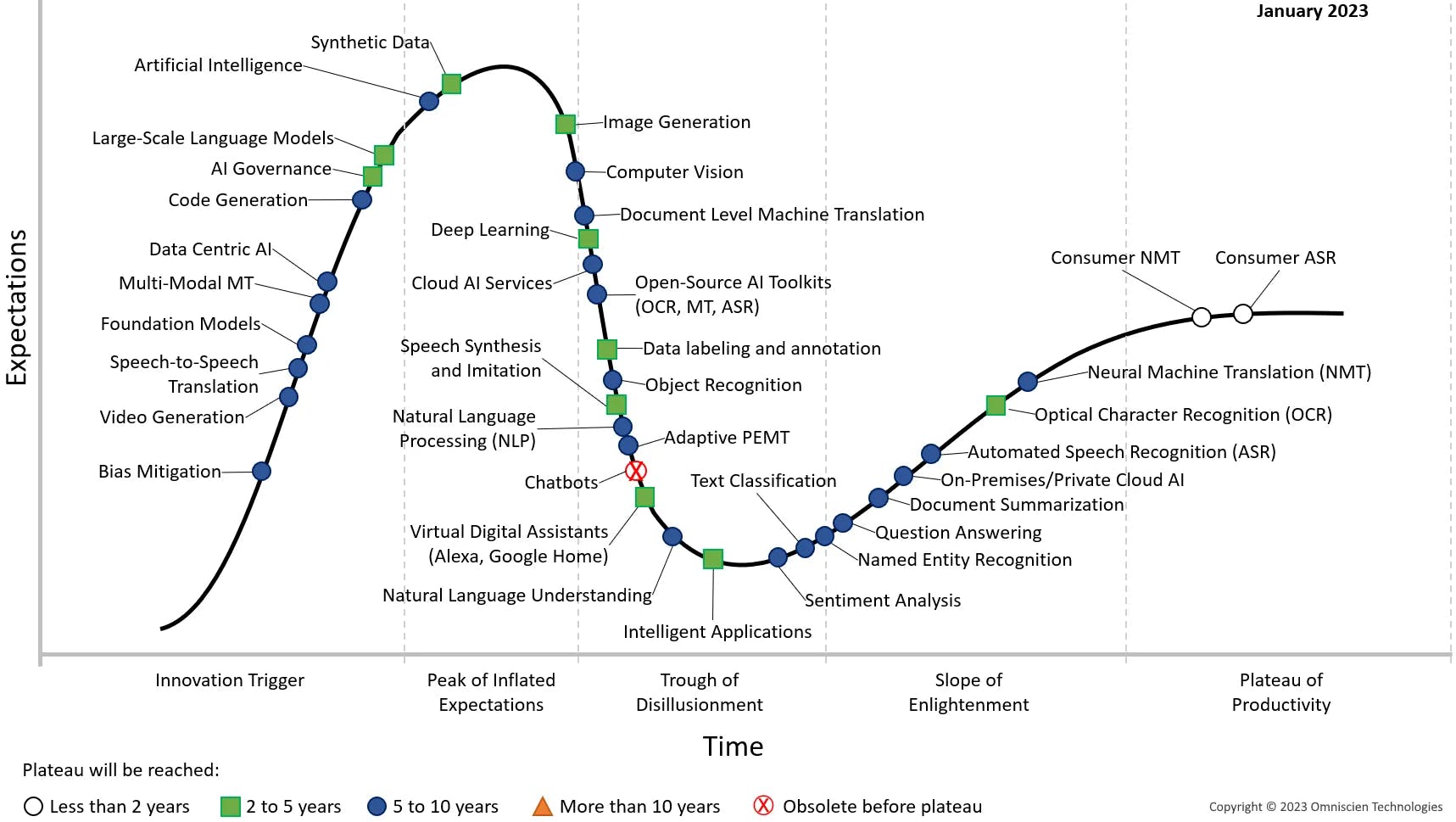Artificial Intelligence (AI) has been a topic of great interest and speculation for decades. The concept of AI Winters, periods of disillusionment and decreased interest in AI, has come and gone in the past. However, in this era of advanced technology, where does AI stand in the Gartner Hype Cycle? And more importantly, what lies ahead for this rapidly evolving field?
The Gartner Hype Cycle is a graphical representation that illustrates the maturity, adoption, and application of specific technologies over time. It consists of five phases: Technology Trigger, Peak of Inflated Expectations, Trough of Disillusionment, Slope of Enlightenment, and Plateau of Productivity. While the creation of AGI is the primary focus of companies like OpenAI, I challenge the notion that the Gartner Hype Cycle accurately applies to the AI landscape. AI is on an unprecedented trajectory and predicts that we haven't seen anything yet.

The AI Journey: From AI Winters to Machine Learning
The concept of AI Winters emerged in the 1960s when there was an unrealistic expectation that artificial intelligence would be solved quickly. However, as time went on, it became clear that the development of AI was far more complex and challenging than initially anticipated. The 80s brought the popularity of expert systems, which aimed to replicate human expertise through programming. While these systems had limitations, they set the stage for further advancements.
In recent years, machine learning has taken center stage. Data mining and the utilization of corporate data became prominent in the early 2000s. Breakthroughs in the last decade have raised expectations once again, with AI becoming a catalyst for innovation and economic growth. The question now is, where does AI stand in the Gartner Hype Cycle?

AI in the Gartner Hype Cycle
The Gartner Hype Cycle suggests that when a technology has a breakout moment, excitement and expectations skyrocket. However, reality eventually sets in, leading to a period of disillusionment. It is during this phase that the true value and practical applications of the technology are evaluated. Finally, as organizations adapt and learn to use technology effectively, it reaches the plateau of productivity.
While one may be optimistic about the potential of AI, one must also acknowledge the challenges and risks that lie ahead. It is crucial to differentiate between hype and substance when evaluating AI's position in the Gartner Hype Cycle. Several factors can shed light on AI's trajectory and potential.
Market Proof and Adoption
One way to assess the validity of AI's hype is to examine market proof and adoption rates. Global investments in AI have been skyrocketing, indicating a growing interest and willingness to invest in the technology. This exponential growth in investment is a strong indicator of AI's potential value. Additionally, mergers and acquisitions in the AI industry point to the adoption and recognition of valuable AI products and services.

Long-Term Value and Practical Applications
Assessing the long-term value and practical applications of AI is crucial to understanding its position in the Gartner Hype Cycle. AI has already demonstrated its ability to solve complex problems, such as drug discovery, vaccine development, and accelerating research in quantum computing and nuclear fusion. Its generative capabilities are also evident in various fields, including image and video generation. However, it is important to remember that new technologies often create new challenges.
The Possibility of a Bubble
With the rapid rise of AI and the corresponding market enthusiasm, questions arise about the possibility of a bubble. Comparisons are drawn to previous tech bubbles, such as Tesla's valuation and the surge in NVIDIA's stock price. However, it is essential to remember that the stock market is not a direct reflection of the technology's true productivity or overall impact on society. It is crucial to exercise caution and not solely rely on market trends to determine AI's future.
The Peak of Inflated Expectations: Utopianism and Salvation Fantasy
As AI continues its upward trajectory, the peak of inflated expectations looms ahead. This phase is characterized by utopianism and the belief that AI can solve all problems and improve every aspect of life. While AI undeniably holds tremendous potential and can alleviate suffering, it is essential to approach it with caution. Every new technology brings with it both benefits and new challenges. Understanding the limits and potential risks is vital.
The Trough of Disillusionment: Navigating Potential Challenges
Beyond the peak of inflated expectations lies the trough of disillusionment. It is during this phase that the realization sets in that all technologies are double-edged swords. AI's dark side becomes more apparent as issues such as privacy erosion, manipulation, and exploitation come to light. The potential for cyberpunk-like scenarios, geopolitical conflicts, and the misuse of AI for harmful purposes must be acknowledged. Society must be prepared to face these challenges head-on.
The Slope of Enlightenment: Synthesizing a New Culture
If we can successfully navigate the trough of disillusionment, the slope of enlightenment awaits us. This phase will require us to synthesize an entirely new culture and adapt to the paradigm shift brought about by AI. Just as the industrial revolution transformed our way of life, AI will bring about significant changes. Our lifestyles will be fundamentally different, and the definition of what it means to be human may evolve. This transition will be disruptive, but it presents an opportunity for growth and progress.
The Plateau of Productivity: A New Normal
The plateau of productivity awaits us after successfully passing through the trough of disillusionment. Here, the full potential of AI will be realized. Post-labor economics, transhumanism, and the synthesis of a new AI-literate culture will reshape our society. It is important to note that this new normal will not be perfect or without challenges. However, with careful navigation and a focus on protecting democracy and human rights, we can march toward redemption and a brighter future.
Embracing the Journey
As we stand amid the AI revolution, it is crucial to recognize that we are still in the early stages of the journey. AI's potential is immense, but we must approach it with realism and a critical eye. While the Gartner Hype Cycle provides a framework for understanding the trajectory of technologies, AI's unique nature and exponential growth require us to question its strict applicability.
The future of AI holds promises and challenges. We must embrace this journey, fostering a culture that values the responsible development and deployment of AI. By doing so, we can navigate the potential pitfalls, push AI's boundaries ethically, and strive for a future where AI contributes to a high standard of living, social mobility, and individual liberty for all.
Disclaimer: The opinions expressed in this article are the author's own and do not constitute financial advice.
Thank you for reading. Stay tuned for more exciting updates on AI and its impact on our world!

